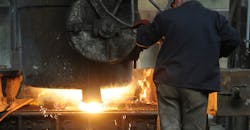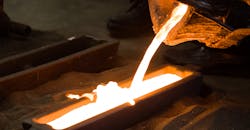The development of high-quality iron castings begins with melting processes and techniques. You control how it is melted, giving you the final call in determining its quality. Everything depends on you.
Molten iron contains desirable and undesirable elements. In a ferrous foundry, you control both of these.
From the scrap metal that is the raw-material source for much of the melt come residual elements like chrome, manganese, nickel, aluminum, etc., that may compromise the quality of finished castings. The effects of these elements can be offset at times, but scrutiny of their presence must be the foundry’s top priority. Everyone involved in the iron-melting process is responsible for controlling the levels of carbon and silicon levels in their melted heats. It’s their daily duty.
In practice, very few foundries make the effort to control the critical, free-oxygen level in molten iron heats. Free-oxygen levels have remained an unknown, quality-compromising factor in the molten iron matrix. Very tiny amounts of free oxygen, measured in parts per million (PPM), have a significant influence on the iron melting process and the finished quality of iron castings.
You control the presence of free-oxygen atoms in the molten iron. Those oxygen atoms come from iron oxide (FeO) present in the slag that forms a cover atop the iron bath. If iron oxide exists in the cover slag, free-oxygen atoms will be transferred to and exist within the iron bath. Because you must control free-oxygen levels you must eliminate iron oxide in the slag.
Once oxygen atoms enter the molten iron bath, nothing can be done to stop the oxidation process. In addition, molten iron exposed to the atmosphere instantly forms iron oxide, so atmospheric contact must be avoided. You accomplish this by establishing a full cover-slag barrier atop the bath.
Cut off the supply of those free oxygen to the bath by eliminating iron oxide in the cover slag.
You can create an FeO-free slag simply by adding DeOX Metal Treatment to the slag blanket. DeOX mixes into the slag and chemically reduces any iron oxide present — effectively stopping oxidation losses and the multiple extenuating issues instigated by free-oxygen atoms.
Decisive steps are needed to address years of inaction that has been the norm for ferrous foundries. It has long been the case that oxidation losses are accepted as inevitable; refractory erosion was tolerated as standard operating practice; crusty slag was the norm; “green poling” cover slag was OK; poor fluidity was a fact of life; poor machinability could not be avoided; inductor-loop plugging always occurs; casting scrap due to oxide floatation surface defects could not be avoided; and so on. The technology is available to you to change all of it. DeOX Metal Treatment is proven effective, but you must take the stepimprove the quality of iron cast, and change the direction of your foundry operation.Your action plan — First, you must determine the extent of the problem of ferrous oxidation in your melting operation. What are the current melting oxidation losses? What portion of casting scrap-rate results from surface defects? What metal chemistry declines are occurring over holding periods? What magnesium-fade rates are encountered? What customer complaints have been registered in regard to casting machinability? What fluidity issues are occurring on the pouring floor? Is plugging occurring on furnace spout, inlets, inductor loops, ladle pouring lips? What volume of slag is being produced? What furnace sidewall buildups are occurring? How is slag removed from furnaces? How often is slag removed?
You must carefully and closely analyze the melting operation, so prepare a checklist: What melting oxidation issues will you address with DeOX Metal Treatment? For example, what are the levels of silicon and carbon lost to oxidation, how is this reflected in cast-iron quality, and what are the costs to the foundry for these losses?
Typically, the savings achieved once carbon and silicon losses stop far exceed cost of the DeOX addition. All other DeOX benefits are “in addition” savings.
Your process plan — It is very easy to evaluate DeOX Metal treatment, but it takes your action to get the process started, and you must start it.
DeOX is a formulation of pet coke and SiC, neither material is harmful. Excess DeOX carries over to the next heat or continues “as-is” without any concerns or issues. It forms a non-sticky, dry type slag that flows out of the furnace into the transfer ladle when the furnace is tapped. It is a harmless slag that will not cause casting defects if it is not removed. All this means that slagging the furnace can be a thing of the past.
You can launch DeOX Metal Treatment several ways: It can be added to an auto-pour before adding in any other area in the melt operation. If you start DeOX Metal Treatment at the auto-pour, add DeOX to the main furnace bath inside the auto-pour and to the inlet. The spout receives carryover from the main bath. It takes hours for DeOX to show results.
Remember, if metal chemistry inside the auto-pour declines when held for any length of time, more DeOX is needed. No chemistry decline occurs when all iron oxide inside the auto-pour has been reduced and neutralized.
Once the iron oxide has been neutralized inside the auto-pour, inductor loop-plugging ceases: The loop or channel will not open up but new plugging formations will cease immediately.
No flux is needed or wanted during DeOX treatment.
In coreless furnace operation, start with two bags of DeOX (50#) for the first two to three heats: This will clean the furnace sidewalls. Then, reduce DeOX to one bag per heat, for up to 15,000# heat size. The theoretical chemistry of the charge will be achieved. Be sure to reduce carbon and silicon additions accordingly.
In vertical channel furnaces, slag cover should be initially converted to FeO-free slag. This may involve adding four to six bags of DeOX at the start. Once DeOX treatment has begun, do not remove slag from the furnace unless the volume is excessive. DeOX stops oxidation of silicon in the melt, decreasing slag volume by 80%, and making slag removal unnecessary.
Your expectations — The need for additional DeOX is determined by the amount of iron oxide on the charge materials. Unlike coreless furnace melting where iron oxide is formed due to agitation of the molten iron and the resulting exposure to the atmosphere, vertical channel furnaces melt without severe metal agitation. This makes the FeO coatings on the charge materials the primary source for iron oxide as long a full slag cover is maintained.
Because FeO presence is reduced in vertical channel furnaces, less DeOX is needed to maintain low iron-oxide levels in the cover slags. The cover slag layer in vertical channel furnaces needs to be maintained: It should not be removed. Minimal slag is produced during melting after oxidation stops. The best of all worlds is realized.
DeOX added to vertical channel furnaces remains active until it reduces iron oxide. Its reactivity with iron oxide doesn’t decrease over time.
The only concern to be anticipated with DeOX Metal Treatment will come after oxidation is stopped, as melt chemistries rise to the theoretical chemistry of the charge materials. This must be foreseen and allowed for in the first DeOX furnace charge. Calculate the theoretical metal chemistries and make adjustments based on full carbon and silicon recoveries.
All of this improvement can be planned for, but you must make the plan. You can chart a new course for your foundry and yourself, with a cost-saving, future-oriented technology available now.
Ron Beyerstedt is the president of Mastermelt LLC. Contact him at [email protected]
This is the final installment in a series of reports addressing the effects of oxygen in iron melting. Also see:
Harmful Effects of Molten Metal Oxidation, FM&T June 2020.
Controlling Iron Oxide to Stop Carbon and Silicon Losses, FM&T July 2020.
Controlling Molten Iron Chemistry and Metal Fluidity, FM&T August 2020
Treating Oxidation to Reduce Iron Casting Scrap, FM&T September 2020
Treating Molten Metal to Reduce Refractory Erosion, FM&T October 2020
About the Author
Ron Beyerstedt
Ron Beyerstedt is the president of Mastermelt LLC. Contact him at [email protected]

